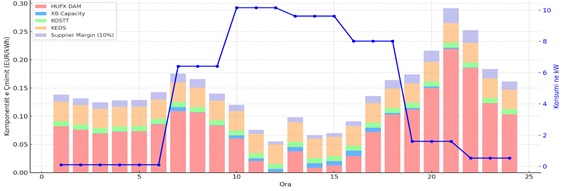Informative summary of the Workshop for Consumers in the Open Electricity Market
Clarification: This document has been prepared as an informative summary of the discussions, presentations, and questions raised during the workshop for consumers in the open electricity market. This workshop was also attended by experts from the Energy Community Secretariat and the Energy Regulatory Office (ERO), who shared technical and regulatory information for educational and informational purposes. This document does not reflect the positions of the Ministry of Economy, the Government of the Republic of Kosovo, or the institutions participating in the workshop.
This material does not constitute legal, technical, or financial advice, and should not be interpreted as guidance. The prices and examples in the illustrative tables at the end of the document have been used solely for demonstration purposes and should not be taken as a reference for actual offers or financial decisions. The information included is of an indicative and general nature, and aims to help consumers better understand the functioning of the liberalized electricity market.
The Ministry of Economy bears no responsibility for the accuracy, updating, or use of this document by third parties, nor for any decision or action taken on the basis of this summary. Consumers are encouraged to consult licensed suppliers and relevant professionals, as well as to refer directly to the laws, bylaws, and official documents for complete and detailed information.
1. Legal Basis and Regulatory Framework
• The market has been liberalized in accordance with Law No. 05/L-085 on Electricity and the bylaws of the ERO.
• Consumers have the right to choose their supplier and negotiate the terms of supply.
1. Pursuant to item 2.8.4 of Article 34 of Law No. 05/L-085 on Electricity, the Supplier must also: define supplier conditions, and make them public in an appropriate manner, no later than thirty (30) days prior to the commencement of electricity supply activities;
1. What is the Free Market?
1. Suppliers compete to offer better prices and conditions.
o The price is no longer regulated by ERO, but is negotiated directly.
o ERO regulates and sets the tariffs for the use of the distribution (KEDS) and transmission (KOSTT) network.
o The market operates based on supply and demand – prices are dynamic.
o Suppliers can offer dynamic prices, fixed for a certain period, or even a combination of various indexes.
1. How to Follow the Process of Changing the Supplier
• Analyze your load profile – this is the basic information required by suppliers. Your load profile can be obtained from KEDS.
• Request and compare offers from different suppliers.
• Sign a contract with the most favorable bidder.
• The supplier notifies the system operator of the switch based on the contract.
1. Role of the Supplier of Last Resort (SLR)
• If you did not have an active contract as of 1 June 2025, KEK, as the SLR, shall temporarily supply you for up to 60 days.
• Do not consider the SLR as a long-term solution.
• This supply may also not be the most economically favorable for you – you should find a regular supplier as soon as possible.
1. Load Profile – A Necessity for Consumers
• The profile describes the hourly distribution of energy consumption.
• Consumers without interval meters must use standard profiles which KEDS, as the Distribution System Operator, is obliged to compile.
1. You or your Supplier, with your authorization, have the right to request this profile from KEDS. Regarding this, contact KEDS via the link https://www.keds-energy.com/ or email address info@keds-energy.com
• Suppliers use this profile to calculate offers and to balance the load in the market.
1. Optimization of Consumption Based on Daily Prices
• Consumers who possess interval meters (An interval meter is a device installed at consumer premises that records energy/power consumption every 15, 30, or 60 minutes) can analyze published prices and shift consumption to hours with lower prices.
• This optimization is important for industrial consumers and businesses that can change their working hours or use alternative sources during peak consumption.
1. Questions Consumers Should Ask Suppliers
• What price model can the supply offers include (fixed, indexed on ALPEX, HUPEX or other exchanges, variable)?
o If indexed on exchanges, discuss whether the price is applied per hour, daily average, weekly or monthly average, base product average, peak consumption or lowest consumption, etc.
o Discuss with the potential supplier whether you have the possibility to optimize your consumption in relation to hourly, base, or peak prices.
o If limits are set regarding a certain volume, i.e., it is not a full-supply contract, the financial responsibility for imbalances should also be discussed.
o Check whether your electricity meter and the equipment you use enable this.
o Monitor your electricity consumption and, where possible, reduce consumption to reduce costs.
• What are the tariffs for cross-border (inter-zonal) capacity if the same are included as a component of the price (may be applied if the electricity price is indexed on regional exchanges)?
o Which auction and which borders are taken as reference?
o In what form is the most economically efficient “route” guaranteed?
• How are costs from KOSTT and KEDS tariffs applied?
• Is there technical assistance, from the Supplier, for consumption management?
• Are there penalties for early termination of the contract?
• How is the quality of service guaranteed to me?
• How will I be notified for outages?
• What does the compensation cover in case of defect or outage?
• Seek assistance from the ERO if you have uncertainties regarding your rights and obligations as consumers. Send your questions to the ERO email address – info@ero-ks.org
• ERO also has the mandate to monitor the market and protect consumers from abusive offers by suppliers.
1. ERO Decisions on KOSTT and KEDS Tariffs
• The decision on the tariffs applied by KOSTT can be found here.
o Since your Supplier pays KOSTT on behalf of your consumption, the applicable tariffs will be invoiced to you by the Supplier, as a cumulative of the following tariff categories:
Use of the transmission system, level 400/220 kV (2.087 EUR/kW/year), and
Use of the transmission system, level 110 kV (4.939 EUR/kW/year), and
System Operation (4.644 EUR/MWh), and
Market Operation (0.018 EUR/MWh), and
RES Fund (2.924 EUR/MWh).
o The tariff for the use of the transmission network is applied based on the maximum load converted to MWh. Referring to the system peak, the average tariff for the use of the transmission system is about 1.4 EUR/MWh.
• The decision on the tariffs applied by KEDS can be found here.
1. Since your Supplier pays KEDS on behalf of your consumption, the applicable tariffs will be invoiced to you by the Supplier, depending on the voltage level your meter is connected to:
Voltage level 35 kV, or
Voltage level 10 kV, or
Voltage level 0.4 kV.
1. Example of the calculation of the final price based on a standard load profile
• The example below is based on:
o a standard load consumption,
o the hour-by-hour price of HUPEX,
o the daily cross-border capacity HU->RS, RS-MK, MK-KS,
o payment for KOSTT and KEDS,
o 10% margin of the Supplier.
• The example is based on prices from 11 June 2025.
o The diagram visually presents the price components,
o The table below presents the calculation.
The example refers to HUPX to demonstrate the inclusion of cross-border capacity, however, to avoid exposure to cross-border costs, it is recommended to use the prices in ALPEX Kosovo.
Diagram: Full structure of the price (with HUPX as index)
Table: Calculation of the retail price

